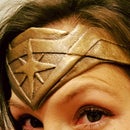Introduction: Build a (Light-Up) Longboard
I wanted to make something that was obviously custom and would blow his mind with awesomeness. I'm stoked that it turned out just add cool add it was in my head.
Watch the VIDEO of it in action.
Step 1: Materials
There are several things that go into making a great longboard. This was my 4th board, 3rd using the press I made. My first board was built without one, and while I think it is cool, the press is so much better. I just wish I had known about this sight when I built the press. Then there would be some instructions on how to build one.
The first thing you need is Baltic Birch Plywood. These come in 5x5 sheets. I had it cut into 1x5 sheets. Longboard grip tape comes 10" wide, so the board doesn't need to be bigger that 12". You will use 2 of the 1x5 sheets.
Wood Glue
Poly urethane
Painters tape
Glow in the Dark paint
Spray paint
Clear grip Tape (purchased on Amazon here)
Trucks and LED wheels (purchased on Amazon here)
TOOLS
Jig saw
Sander
Drill & bits
Airbrush
File
Screw driver
Nut driver
Step 2: Design the Board
I sat with my son for awhile months ago to get a sense of the shape that he wanted. After much debate on what was practical and rideable, we came up with a general design. Then, to put in into motion and keep it symmetrical, I got out the butcher paper. I don't have pictures of this process very well here, but I will explain it.
Fold the paper in half. This way, you only have to draw half the design and you can get perfect symmetry. One of the ways that I get the longer lines to be such a smooth curve is to get a metal ruler out and bend it to the line that I want. Then I have someone draw that line while I hold the ruler in place. Once I get the drawing all set, then I can just cut it out of the paper.
Step 3: Draw Design on Wood
Start by drawing a centerline down the 1x5 sheet. This will help you to match up the paper symmetrically to the wood.
Then place the paper on the wood and trace it out. This will be the guide for where to lay the board on the press add well as where to cut it out after it has been pressed.
Step 4: Glue Wood
Once the design is on it is time to glue the two boards together. It is important to apply a layer of glue to both boards.
Pour a generous amount on to each side and then spread it out evenly. I used a painters stir stick that you can get free at Home Depot for this.
Once you have it spread evenly and completely over both boards it is time to put them together. Match them up and lay them together starting at one edge to prevent bubbles in the glue.
As soon as this step is done you will want to move quickly to get it in the press.
Step 5: Put It in the Press
I decided to try something new in my press to increase the concave of the top. I'm not sure it really changed much in the end, but it was worth a try. As you can see in the picture I added another piece of 1/4 inch ply to the press and a couple strips on the side.
To start with the press, make sure that the board is centered on the press. Also, there is a low point on the press. This should hit at the top 1/3 of the board. Once this is in the right place, fit the rib for the low point down on the board and tighten it a bit. Then, progressively lay the other ribs down moving up and down the board from there. This allows any air bubbles to be pressed out from this spot. Once all the ribs are on, then comes the process of tightening them down. I use my body weight to help with this so I can get it well pressed. You can tell it is where it needs to be when there is no more gap between the ribs and the board.
Step 6: Cut Out the Shape
After about 24 hours of letting the glue dry, the board is ready to be taken out of the press. You will be able to see the shape of the board at this point.
Then I got the jig saw out and started cutting. Be careful in the detailed portion to make sure the cut is precise on both sides. This won't take very long, so there is no need to rush it.
Step 7: Sand Edges
Jig saws are not super friendly for clean edges. Some turned out better than others. Either way it is good to round of all the edges of the board. This gives it a clean look and is significantly nicer to hold.
I used my hand sander for most of this. I simply just went around all the edges and cleaned it up the best I could. For the tight corners I used a file to get it looking crisp.
Step 8: Add Holes for Trucks
The board is really starting to come together now. Once the board is cut out you can drill the holes for the trucks into the board.
Since the center line is still drawn on the board, place the trucks centered on the board where you want them to be. Then, mark where the holes will go by marking the holes in the trucks. Then, get a drill bit that is the same size as the screws for the trucks.
I tried something new to prevent blow out on the back side of the drilling. It didn't really work. I should have just placed it on some wood and drilled through that... next time, right?!
Once the holes are drilled we are ready for some artwork.
Step 9: Sketch on Design
This was the fun part. I had some ideas of what I wanted it to look like.
On the top side I wanted my son's name in a circle add well as my logo.
On the bottom I had doodled several ideas based on what I though my son would think looked cool. Then I sketched it out on the board. I really liked the way the sketch looked and decided to try to keep that look as much as possible in the painting process.
Step 10: Coat of Poly
After the drawings were in place I put a protective coat of poly over the whole board. This keeps the paint from seeping into the wood in weird and unpredictable ways. It also protects the wood from the weather.
Step 11: Paint the Bottom
This was a fun process, but a bit of a labor of love. I started by masking out the inside of the design so I could paint the background. To get the curves I just used lots of small strips overlapping each other. Then I covered the big portion with paper.
Once this was masked out I went in with my spray paint. I used white and silver paint for this. I started by spraying white over the whole board. I then outlined the board with the silver. Then I went back over with the white to make sure it was really crisp right around the design.
After this dried I removed the tape for the wings. I kept the cover up on the fist as this was going to stay the natural wood color. I then taped off the outside of the wings. This is where I got to bust out my new airbrush. This was it's maiden voyage, and there is still a lot I need to learn about using it. It sure was fun though.
Once the wings were painted I was able to remove all the tape. This is where I was able to maintain the sketch look to the design. I got a black paint marker and sketched in all the lines again. It ended up looking really great. Once all the paint was dry I covered it all up with 2 or 3 coats of polyurethane.
Step 12: Paint the Top
The top was a little more simple. I knew I wanted the logos to glow in the dark, so I found some glow in the dark paint. Having used this before, I knew that it would need several coats. I actually put a few drops of blue food coloring in the paint as well since I wanted more of the color to show through. I put 3-4 coats of paint on to achieve a good solid glow. The last coat was rather thick to make sure it glowed well.
Once all that was dry I got out the paint markers again. I have a thick and a thin one. For the thinner lines I obviously used the thinner marker.
Once all this had dried, I added another coat of polyurethane to the top to protect the paint jobs. I didn't need to do more that that because it would be covered with grip tape.
Step 13: Grip Tape
Putting grip tape on can be a rather delicate process, especially if the width of the board at some points is the same as the paper. The best way I have found to do this is line up the paper over the top of the board. Then, just remove the top couple inches of the backing paper and stick that to the nose of the board. Once that is stuck on, slowly remove more backing and roll it on to the board. This will stop any mishaps with the tape sticking to itself.
Once the tape is all on, then comes the processes of cutting it out. I use a file for this. Simply scrape the file along the edge of the board and you will create a nice transition from tape to board. It does take a little more time than cutting it with a knife, but I think it ends up looking better.
Also, roll out any air that is caught under the tape from center to the sides. This won't be big, but for this, since the tape was clear, I wanted to make sure the logos showed through really well.
Step 14: Put on Trucks & Wheels
You will need to punch through the grip tape for the holes to be accessed. This is pretty simple. Then put your screws through and turn the board over. The trucks should line up well onto the screws. If they don't, don't panic. Just get the drill out and clean it up by drilling through the hole in the truck.
With the screws through, put on your washers and tighten down the nuts. I used a screw driver and a nut driver for this.
Step 15: Try It Out
This should do the job! Now comes the fun part. Take it out and test it. I was able to give this to my son for his birthday and he was pretty stoked to try it out (so way I for that matter).
The light up wheels turned out so well. It was really cool to ride it around in the dark and look like you are riding a Tron Longboard.
If you like this Instructable, I would appreciate a vote in the Make it Move and Crafting 101 contests.

Participated in the
Crafting 101

Participated in the
Move It










